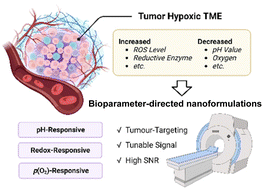Bioparameter-directed nanoformulations as MRI CAs enable the specific visualization of hypoxic tumour
Abstract
A malignant tumour has hypoxic cells of varying degrees. The more severe the hypoxic degree, the more difficult the prognosis of the tumour and the higher the recurrence rate. Therefore, tumour hypoxia imaging is crucial. Magnetic resonance imaging (MRI) shows its strength in high resolution, depth of penetration and noninvasiveness. However, it needs more excellent contrast agents (CAs) to combat the complex tumour microenvironment (TME) and increased targeting of tumours to enhance clinical safety. Many research studies have focused on developing hypoxia-responsive MRI CAs that take advantage of the unique characteristics of hypoxic tumours. The low oxygen pressure, acidic TME, and up-regulated redox molecule levels found in hypoxic tumours serve as biological stimuli for nanoformulations that can accurately image the hypoxic region. This review highlights the importance of developing bioparameter-directed nanoformulations as MRI CAs for accurate tumour diagnosis. The design strategies and mechanisms of tumour-hypoxia imaging with nanoformulations are exemplified, with a focus on pH-responsiveness, redox-responsiveness, and p(O2)-responsiveness. The promising future of bioparameter-responsive nanoformulations for accurate tumour diagnosis and personalised cancer treatment is discussed.

- This article is part of the themed collection: Analyst Review Articles 2023


 Please wait while we load your content...
Please wait while we load your content...